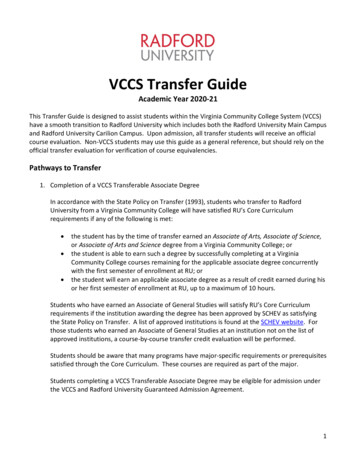
Transcription
Cloud ComputingHwajung LeeKey Reference:Prof. Jong-Moon Chung’s Lecture Notes at Yonsei University
Cloud Computing Cloud Introduction Cloud Service Model Big Data Hadoop MapReduce HDFS (Hadoop Distributed File System)
MapReduce
MapReduceHadoop Hadoop is a Reliable Shared Storage and Analysis System Hadoop HDFS MapReduce α- HDFS provides Data Storage- HDFS: Hadoop Distributed FileSystem- MapReduce provides Data Analysis- MapReduce Map Function Reduce Function
MapReduceScaling Out Scaling out is done by the DFS (Distributed FileSystem),where the data is divided and stored in distributed computers& servers Hadoop uses HDFS to move the MapReduce computation toseveral distributed computing machines that will process apart of the divided data assigned
MapReduceJobs MapReduce job is a unit of work that needs to be executed Job types: Data input, MapReduce program, ConfigurationInformation, etc. Job is executed by dividing it into one of two types of tasks Map Task Reduce Task
MapReduceNode types for Job execution Job execution is controlled by 2 types of nodes Jobtracker Tasktracker Jobtracker coordinates all jobs Jobtracker schedules all tasks and assigns the tasks to tasktrackers
MapReduce Tasktracker will execute its assigned taskTasktracker will send a progress reports to the JobtrackerJobtracker will keep a record of the progress of all jobs executed
MapReduceData flow Hadoop divides the input into input splits (or splits) suitablefor the MapReduce job Split has a fixed-size Split size is commonly matched to the size of a HDFS block(64 MB) for maximum processing efficiency
MapReduceData flow Map Task is created for each split Map Task executes the map function for all records within the split Hadoop commonly executes the Map Task on the node where theinput data resides
MapReduceData flow Data-Local Map Task Data locality optimizationdoes not need to use the cluster network Data-local flow process shows why theOptimal Split Size 64 MB HDFS Block Size
MapReduceData flowNodeRackData Center Rack-Local Map Task A node hosting theHDFS block replicas fora map task’s input splitcould be running other map tasks Job Scheduler will look for a free map slot ona node in the same rack as one of the blocksMap TaskHDFS Block
MapReduceData flow Off-Rack Map Task Needed when theJob Schedulercannot perform data-local or rack-local map tasks Uses inter-rack network transfer
MapReduceMap Map task will write its output to the local disk Map task output is not the final output, it is only theintermediate outputReduce Map task output is processed by Reduce Tasks to produce the finaloutput Reduce Task output is stored in HDFS For a completed job, the Map Task output can be discarded
MapReduceSingle Reduce Task Node includes Split, Map, Sort, and Output unitLight blue arrows show data transfers in a nodeBlack arrows show data transfers between nodes
MapReduceSingle Reduce Task Number of reduce tasks is specifiedindependently, and is not based onthe size of the input
MapReduceCombiner Function User specified function to run on the Map output Forms the input to the Reduce function Specifically designed to minimize the data transferred betweenMap Tasks and Reduce Tasks Solves the problem of limited network speed on the clusterand helps to reduce the time in completing MapReduce jobs
MapReduceMultiple Reducer Map tasks partition their output, each creating one partition foreach reduce task Each partition may use many keys and key associatedvalues All records for a key are kept in a single partition
MapReduceMultiple ReducersShuffle Shuffle process is used in the data flowbetween the Map tasks and Reduce tasks
MapReduceZero Reducer Zero reducer usesno shuffle process Applied when all of theprocessing can be carriedout in parallel Map tasks
HDFS
HDFSHadoop Hadoop is a Reliable Shared Storage and Analysis System Hadoop HDFS MapReduce α- HDFS provides Data Storage- HDFS: Hadoop Distributed FileSystem- MapReduce provides Data Analysis- MapReduce Map Function FunctionReduce
HDFSHDFS: Hadoop Distributed FileSystem DFS (Distributed FileSystem) is designed for storagemanagement of a network of computers HDFS is optimized to store large terabyte size files withstreaming data access patterns
HDFSHDFS: Hadoop Distributed FileSystem HDFS was designed to be optimal in performance for a WORM(Write Once, Read Many times) pattern HDFS is designed to run on clusters of general computers& servers from multiple vendors
HDFSHDFS Characteristics HDFS is optimized for large scale and high throughput dataprocessing HDFS does not perform well in supporting applications thatrequire minimum delay (e.g., tens of milliseconds range)
HDFSBlocks Files in HDFS are divided into block size chunks 64 Megabyte default block size Block is the minimum size of data that it can read or write Blocks simplifies the storage and replication process Provides fault tolerance & processing speed enhancementfor larger files
HDFSHDFS HDFS clusters use 2 types of nodes Namenode (master node) Datanode (worker node)
HDFSNamenode Manages the filesystem namespace Namenode keeps track of the datanodes that have blocks ofa distributed file assigned Maintains the filesystem tree and the metadata for all the filesand directories in the tree Stores on the local disk using 2 file forms Namespace Image Edit Log
HDFSNamenode Namenode holds the filesystem metadata in its memory Namenode’s memory size determines the limit to thenumber of files in a filesystem But then, what is Metadata?
HDFSMetadata Traditional concept of the library card catalogs Categorizes and describes the contents and context of the datafiles Maximizes the usefulness of the original data file by making iteasy to find and use
HDFSMetadata Types Structural Metadata Focuses on the data structure’s design and specification Descriptive Metadata Focuses on the individual instances of application data orthe data content
HDFS Datanodes Workhorse of the filesystem Store and retrieve blocks when requested by the client orthe namenode Periodically reports back to the namenode with lists ofblocks that were stored
HDFSClient Access Client can access the filesystem (on behalf of the user) bycommunicating with the namenode and datanodes Client can use a filesystem interface (similar to a POSIX(Portable Operating System Interface)) so the user code doesnot need to know about the namenode and datanodes tofunction properly
HDFSNamenode Failure Namenode keeps track of the datanodes that have blocks of adistributed file assigned Without the namenode, the filesystem cannot be used If the computer running the namenode malfunctions thenreconstruction of the files (from the blocks on the datanodes)would not be possible Files on the filesystem would be lost
HDFSNamenode Failure Resilience Namenode failure prevention schemes1. Namenode File Backup2. Secondary Namenode
HDFSNamenode File Backup Back up the namenode files that form the persistent state ofthe filesystem’s metadata Configure the namenode to write its persistent state tomultiple filesystems Synchronous and atomic backup Common backup configuration Copy to Local Disk and Remote FileSystem
HDFSSecondary Namenode Secondary namenode does not act the same way as thenamenode Secondary namenode periodically merges the namespace imagewith the edit log to prevent the edit log from becoming too large Secondary namenode usually runs on a separate computer toperform the merge process because this requires significantprocessing capability and memory
HDFSHadoop 2.x Release Series HDFS Reliability Enhancements HDFS Federation HDFS HA (High-Availability)
HDFSHDFS Federation Allows a cluster to scale by adding namenodes Each namenode manages anamespace volume and a block pool Namespace volume is made up of the metadata for the namespace Block pool contains all the blocks for the files in the namespace
HDFS HDFS Federation Namespace volumes are all independent Namenodes do not communicate with each other Failure of a namenode is also independent to other namenodes A namenode failure does not influence the availability ofanother namenode’s namespace
HDFSHDFS High-Availability Pair of namenodes (Primary & Standby) are set to be in ActiveStandby configuration Secondary namenode stores the latest edit log entries and anup-to-date block mapping When the primary namenode fails, the standby namenodetakes over serving client requests
HDFSHDFS High-Availability Although the active-standby namenode can takeover operationquickly (e.g., few tens of seconds), to avoid unnecessarynamenode switching, standby namenode activation will beexecuted after a sufficient observation period(e.g., approximately a minute or a few minutes)
References V. Mayer-Schönberger, and K. Cukier, Big data: A revolution that will transform how we live,work, and think. Houghton Mifflin Harcourt, 2013. T. White, Hadoop: The Definitive Guide. O'Reilly Media, 2012. J. Venner, Pro Hadoop. Apress, 2009. S. LaValle, E. Lesser, R. Shockley, M. S. Hopkins, and N. Kruschwitz, “Big Data, Analyticsand the Path From Insights to Value,” MIT Sloan Management Review, vol. 52, no. 2,Winter 2011. B. Randal, R. H. Katz, and E. D. Lazowska, "Big-data Computing: Creatingrevolutionary breakthroughs in commerce, science and society," ComputingCommunity Consortium, pp. 1-15, Dec. 2008. G. Linden, B. Smith, and J. York. "Amazon.com Recommendations: Item-to-ItemCollaborative Filtering," IEEE Internet Computing, vol. 7, no. 1, pp. 76-80, Jan/Feb. 2003.
References J. R. GalbRaith, "Organizational Design Challenges Resulting From Big Data,"Journal of Organization Design, vol. 3, no. 1, pp. 2-13, Apr. 2014. S. Sagiroglu and D. Sinanc, “Big data: A review,” Proc. IEEE International Conference onCollaboration Technologies and Systems, pp. 42-47, May 2013. M. Chen, S. Mao, and Y. Liu, “Big Data: A Survey,” Mobile Networks andApplications, vol. 19, no. 2, pp. 171-209, Jan. 2014. X. Wu, X. Zhu, G. Q. Wu, and W. Ding, ‘‘Data Mining with Big Data,’’ IEEE Transactions onKnowledge and Data Engineering, vol. 26, no. 1, pp. 97–107, Jan. 2014. Z. Zheng, J. Zhu, and M. R. Lyu, ‘‘Service-Generated Big Data and Big Data-as-a- Service:An Overview,’’ Proc. IEEE International Congress on Big Data, pp. 403– 410, Jun/Jul. 2013.
References I. Palit and C.K. Reddy, “Scalable and Parallel Boosting with MapReduce,” IEEE Transactionson Knowledge and Data Engineering, vol. 24, no. 10, pp. 1904-1916, 2012. M.-Y Choi, E.-A. Cho, D.-H. Park, C.-J Moon, and D.-K. Baik, “A Database SynchronizationAlgorithm for Mobile Devices,” IEEE Transactions on Consumer Electronics, vol. 56, no. 2,pp. 392-398, May 2010. IBM, What is big data?, ig-data.html[Accessed June 1, 2015] Hadoop Apache, http://hadoop.apache.org Wikipedia, http://www.wikipedia.orgImage sources Walmart Logo, By Walmart [Public domain], via Wikimedia Commons Amazon Logo, By Balajimuthazhagan (Own work) [CC BY-SA ], via Wikimedia Commons
HDFS Secondary Namenode Secondary namenode does not act the same way as the namenode Secondary namenode periodically merges the namespace image with the edit log to prevent the edit log from becoming too large Secondary namenode usually runs on a separate computer to perform the merge process because this requires significant











